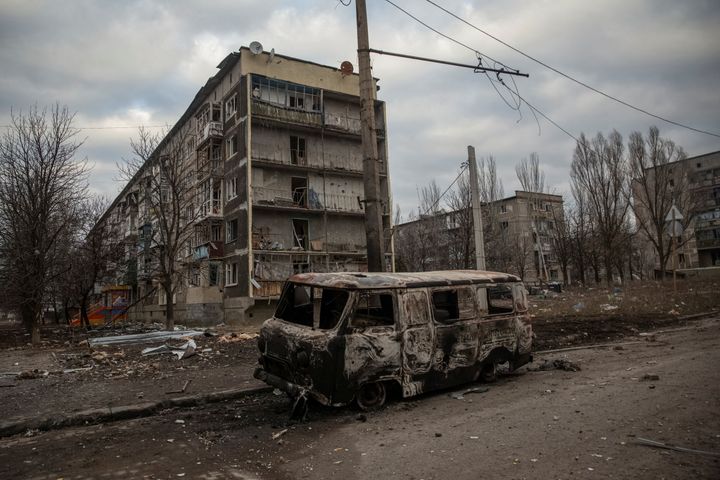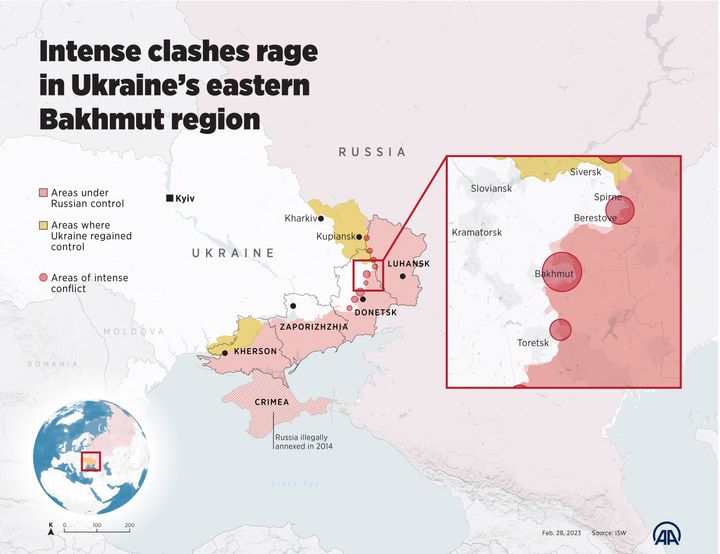A Ukrainian city Russia has been pounding into rubble is thought to be on the brink of being captured by Vladamir Putin’s troops in a rare win for the invaders.
Bakhmut is in Ukraine’s Donetsk region, part of which is under the control of Russia and its proxy forces.
For weeks, Russian forces have been stepping up their drive to encircle the town and seize what would be its first major prize in more than six months.
The Ukrainian leadership vowed again this week to keep defending the city, but some observers have warned that holding on to it could be too dangerous and costly.
Why is Bakhmut important?
The industrial city of salt and gypsum mines – which is also known for its sparkling wine production in historic underground caves – has become a symbol of Ukrainian resistance.
Bakhmut, in the Donetsk region of the country’s industrial heartland known as the Donbas, had a pre-war population of around 70,000, but now lies in ruins after months of intense trench warfare.

When a separatist rebellion engulfed the Donbas in April 2014, weeks after Moscow’s illegal annexation of Ukraine’s Crimean peninsula, Russia-backed separatists won control of the city but lost it a few months later.
The scene of some of the war’s bloodiest battles, Russia itself has suffered heavy troop casualties in a months-long but so far futile campaign.
Capturing Bakhmut would be a symbolic win for Russia following its misjudged, morale-sapping invasion. While the city itself is not seen as strategically important, it would be a stepping stone for taking the rest of the entire Donbas region – one of Moscow’s stated war aims when it invaded a year ago.
But Nato secretary-general Jens Stoltenberg, like other Western officials, has played down the significance of Bakhmut’s potential capture, arguing that this “does not necessarily reflect any turning point of the war, and it just highlights that we should not underestimate Russia”.
The fight for Bakhmut has been likened to Ukraine’s dogged defence of Mariupol earlier in the war, which tied up Russian forces for months, preventing the Kremlin from deploying them elsewhere.

How did the fighting evolve?
Russian troops first attempted to recapture Bakhmut in early August but were pushed back.
The fighting abated in the following months as the Russian military faced Ukrainian counter-offensives in the east and the south, but it resumed at full pace late last year. In January, the Russians captured the salt-mining town of Soledar just a few miles north of Bakhmut and advanced to the city’s suburbs.
The relentless Russian bombardment has reduced Bakhmut to a wasteland with few buildings still standing. Russian and Ukrainian soldiers have fought ferocious house-to-house battles in the ruins. Military experts note that Ukraine has turned Bakhmut into a meat grinder for Russia’s most capable forces.
What’s happening now?
Efforts by Russian forces to capture the industrial city have intensified recently.
By the end of February, the Russians approached the only highway leading out of the city and targeted it with artillery, forcing Ukrainian defenders to rely increasingly on country roads, which are hard to use before the ground dries.
Russian troops, aided by mercenary fighters from the Wagner Group, are trying to cut Ukraine’s supply lines and force them to surrender or withdraw. On Wednesday, Yevgeny Prigozhin, the rogue millionaire who owns the Wagner Group, said his fighters had captured all of the eastern part of Bakhmut. If true, that would mean Russian forces now control nearly half the city in their costly push.
How has Ukraine responded?
Ukrainian authorities have hailed the city as the invincible “fortress Bakhmut” that has destroyed waves of Russian assailants.
As Russian pincers were closing on the city, a presidential aide warned last week that the military could “strategically pull back” if needed. But on Monday, Ukrainian president Volodymyr Zelenskyy and his top generals decided that the army will keep defending Bakhmut and reinforce its troops there.
What next?
The fight for Bakhmut comes ahead of spring offensives and counter-offensives, with history suggesting the thaw can ruin the plans of armies attacking Ukraine and western Russia, turning roads into rivers and fields into quagmires, with armoured vehicles becoming stuck in boggy fields.
The Ukrainian military has already strengthened defensive lines west of Bakhmut to block the Russian advance if Ukrainian troops finally retreat from the city. The nearby town of Chasiv Yar that sits on a hill just a few miles west could become the next bulwark against the Russians. Further west are Kramatorsk and Sloviansk, the heavily fortified Ukrainian strongholds in Donetsk.
And even as the Russian military tries to pursue its offensive in Donetsk, it needs to keep large contingents in other sections of the Donbas and in the southern Zaporizhzhia region where Ukrainian forces are widely expected to launch their next counter-offensive.

